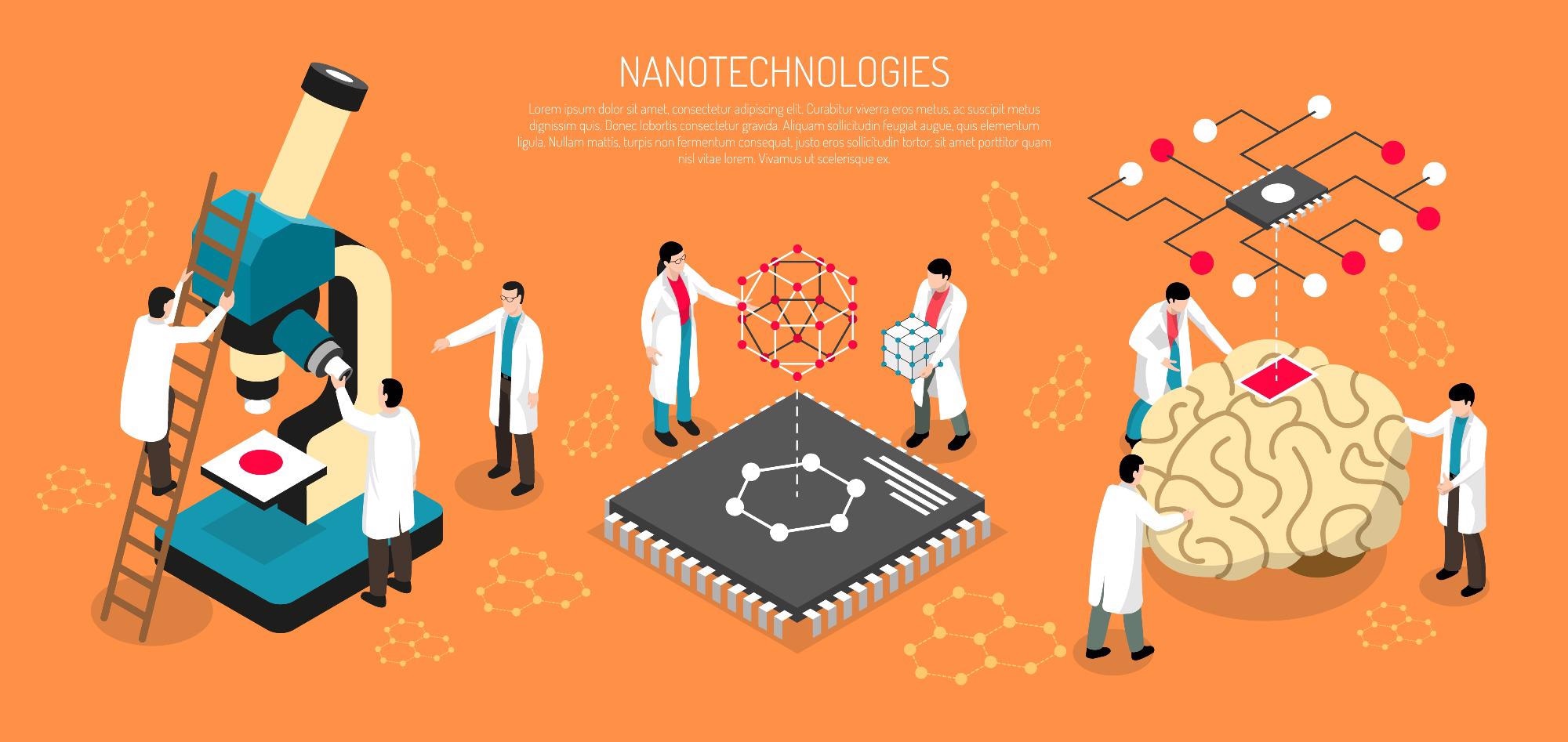As a bridge between fundamental research and the industrial application of nanotechnology, nanofabrication methods are essential in creating novel nanoscale structures, devices, and materials with unique properties. This article aims to overview the existing and emerging techniques for scalable, reliable, and cost-effective manufacturing at the nanoscale.

Image Credit: Macrovector/Shutterstock.com
Nanotechnology enables the understanding and control of matter at length scales between one and a few hundred nanometers, where the quantum effects dominate the properties of the materials.
The use of nanoscale materials has started quite early in human history and dramatically increased in the last 100 years. The study of small nanoparticles was pioneered by Richard Zsigmondy, an Austro-Hungarian colloid chemist, who was awarded the 1925 Nobel Prize in Chemistry. He used the term 'nanomatter' when characterizing particles such as gold colloids by using a microscope.
Building with Atoms and Molecules
In 1959, Richard Feynman introduced the idea of manipulating matter at the atomic level. The future Nobel Laureate (he was awarded the 1965 Nobel Prize in Physics) presented a lecture at a meeting of the American Physical Society, where he speculated about miniaturized electronic components, atom-by-atom manufacturing, and novel optoelectronic and photonic technologies.
Feynman, who foresaw many aspects of modern nanoscience, together with K. Eric Drexler, who in 1986 hypothesized on how molecules and atoms can be manipulated and assembled into complex nanostructures, are considered the fathers of modern nanotechnology.
Nanotechnology Is Changing the World
Since then, nanotechnology has become the foundation for many remarkable applications leading to exponential growth in almost every industrial sector. In the last three decades, rapid developments in physics, chemistry, engineering, and material science manipulated individual molecules and atoms' reality, thus enabling various manufacturing processes at the nanoscale, usually referred to as nanofabrication.
Nanofabrication can be defined as a process of assembling one-, two- or three-dimensional structures at the scale of 1-100 nm with a high degree of functionality and structural complexity. There are different methods for creating functional nanostructures that can be divided into top-down and bottom-up approaches.
Top-Down and Bottom-Up Nanofabrication
In the top-down approach, the starting material is reshaped into the desired smaller structures by using physical or chemical processes, such as electron or ion beam milling, laser ablation, and reactive ion etching, that remove excess material until the final structure is obtained.
In contrast, bottom-up nanofabrication relies on the formation of nanostructures from individual atoms and molecules. Processes include chemical and physical vapor deposition (CVD and PVD), self-assembly, and epitaxial growth.
The Lurie Nanofabrication Facility at the University of Michigan
Video Credit: Electrical and Computer Engineering at Michigan/YouTube.com
Industrial Applications of Nanotechnology
The majority of the industrial nanofabrication processes employ a combination of the two approaches and can be loosely divided into three major sub-processes: thin film deposition, lithographic patterning, and chemical or physical etching.
Thin films are layers of polymers, metals, semiconductors, or other functional materials with nanometer-level thickness. They are fabricated using a variety of deposition processes, including CVD, PVD, atomic layer deposition, and molecular beam epitaxy.
The lithography process involves patterning the as-deposited thin films to create integrated circuits or nanoelectromechanical systems. The latest generation of optical nanolithographic systems employs X-ray, extreme UV, or charged particles beams to create nanoscale patterns with a spatial resolution of less than 10 nm.
The pattern transfer is finalized by an etching process that selectively removes the unnecessary parts of the thin film
Downscaling of Functional Structures and Devices
Such a combination of top-down and bottom-up methods, for example, underpins the tremendous advances in microelectronics and over the last 30 years.
With the development of the UV and extreme UV nanofabrication processes that permit the creation of structures smaller than 10 nm, the semiconductor industry has been able to continuously increase the integration density of the electronic circuits.
The technological developments behind the large-scale production of advanced integrated circuits, in turn, enabled the transfer of cost-effective nanofabrication techniques to the fields of telecommunications, optoelectronics, and photonics.
Nanomanufacturing can also help create materials with novel properties. With the discovery of nanomaterials like fullerenes, carbon nanotubes, graphene, nanodots, and metallic nanoparticles, a lot of academic and industrial research and development efforts were directed at incorporating such nanomaterials in the manufacturing of advanced construction materials, consumer goods, textiles, and healthcare products.
Surface nanopatterning (to create superhydrophobic surfaces) together with metallic nanoparticle coatings are used in antimicrobial applications. Building materials benefit from nanostructured coatings that enable self-cleaning and antifouling functionality.
Automotive and aerospace industries utilize metal oxide nanoparticles for temperature and corrosion protection, and carbon nanotube-based nanocomposite materials as high-strength structural materials.

Image Credit: Ico Maker/Shutterstock.com
Nanofabrication Inspired by Biology
The so-called 'soft nanotechnology', based on the self-assembly of large organic molecules (polymers and proteins), is an emerging field with rapidly expanding industrial applications.
The concept of using cheap and sustainable biobased resources to fabricate organic nanostructures is particularly attractive in the context of a circular economy. Nanoscale biomolecular structures are used for targeted drug delivery, rapid testing, high-throughput gene sequencing, and vaccines' latest generation.
Researchers are exploring ways to mimic photosynthesis, a complex interplay of molecular self-assembly and quantum mechanics, to create novel energy harvesting devices with nearly 100% quantum efficiency.
Prospects for Greater Impact in the Future
With the rapidly expanding applications of nanotechnology in the industry, there is a growing need for more versatile, scalable, and sustainable nanofabrication methods. An exciting perspective is the ability to create dynamical nanoscale structures capable of exhibiting a much broader range of functionalities.
To achieve this, scientists are learning from complex biological systems to take advantage of the engineering principles that drive nature's molecular machines.
Continue reading: An In-Depth Look at Top Down Nanofabrication.
References and Further Reading
Subhan, M.A., et al. (2021) Advances with Molecular Nanomaterials in Industrial Manufacturing Applications. Nanomanufacturing 1, 75-97. Available at: https://doi.org/10.3390/nanomanufacturing1020008
Nasrollahzadeh, M., et al. (2019) An Introduction to Nanotechnology. Interface Science and Technology, 28, 1-27. Available at: https://doi.org/10.1016/B978-0-12-813586-0.00001-8
Bayda, S., et al. (2019) The History of Nanoscience and Nanotechnology: From Chemical-Physical Applications to Nanomedicine. Molecules, 25(1), 112. Available at: https://dx.doi.org/10.3390%2Fmolecules25010112
Singh, N.A. (2017) Nanotechnology innovations, industrial applications and patents. Environ Chem Lett 15, 185–191. Available at: https://doi.org/10.1007/s10311-017-0612-8
Disclaimer: The views expressed here are those of the author expressed in their private capacity and do not necessarily represent the views of AZoM.com Limited T/A AZoNetwork the owner and operator of this website. This disclaimer forms part of the Terms and conditions of use of this website.